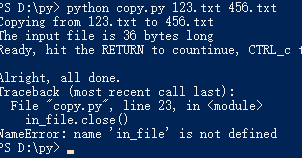本来面目
from sys import argv
from os.path import exists
script, from_file, to_file = argv
print(f"Copying from {from_file} to {to_file}")
#we could do these two on noe line, how?
in_file =open(from_file)
indata = in_file.read()
print(f"The input file is {len(indata)} bytes long")
print("Ready, hit the RETURN to countinue, CTRL_c to abort")
input()
out_file = open(to_file,'w')
out_file.write(indata)
print("Alright, all done.")
out_file.close()
in_file.close()

第一次简化
in_file =open(from_file)
indata = in_file.read()
合为 indata = open(from_file).read()
from sys import argv
from os.path import exists
script, from_file, to_file = argv
print(f"Copying from {from_file} to {to_file}")
#we could do these two on noe line, how?
indata = open(from_file).read()
print(f"The input file is {len(indata)} bytes long")
print("Ready, hit the RETURN to countinue, CTRL_c to abort")
input()
out_file = open(to_file,'w')
out_file.write(indata)
#open(to_file,'w').write(open(from_file).read())
print("Alright, all done.")
out_file.close()
in_file.close()

会报错,因为写了 indata = open(from_file).read() 就无序写关闭语句in_file.close()
以为其中的read一旦运行,文件就会被Python关闭掉
from sys import argv
from os.path import exists
script, from_file, to_file = argv
print(f"Copying from {from_file} to {to_file}")
#we could do these two on noe line, how?
indata = open(from_file).read()
print(f"The input file is {len(indata)} bytes long")
print("Ready, hit the RETURN to countinue, CTRL_c to abort")
input()
out_file = open(to_file,'w')
out_file.write(indata)
#open(to_file,'w').write(open(from_file).read())
print("Alright, all done.")
out_file.close()

改成一句话
from sys import argv
from os.path import exists
script, from_file, to_file = argv
open(to_file,'w').write(open(from_file).read())